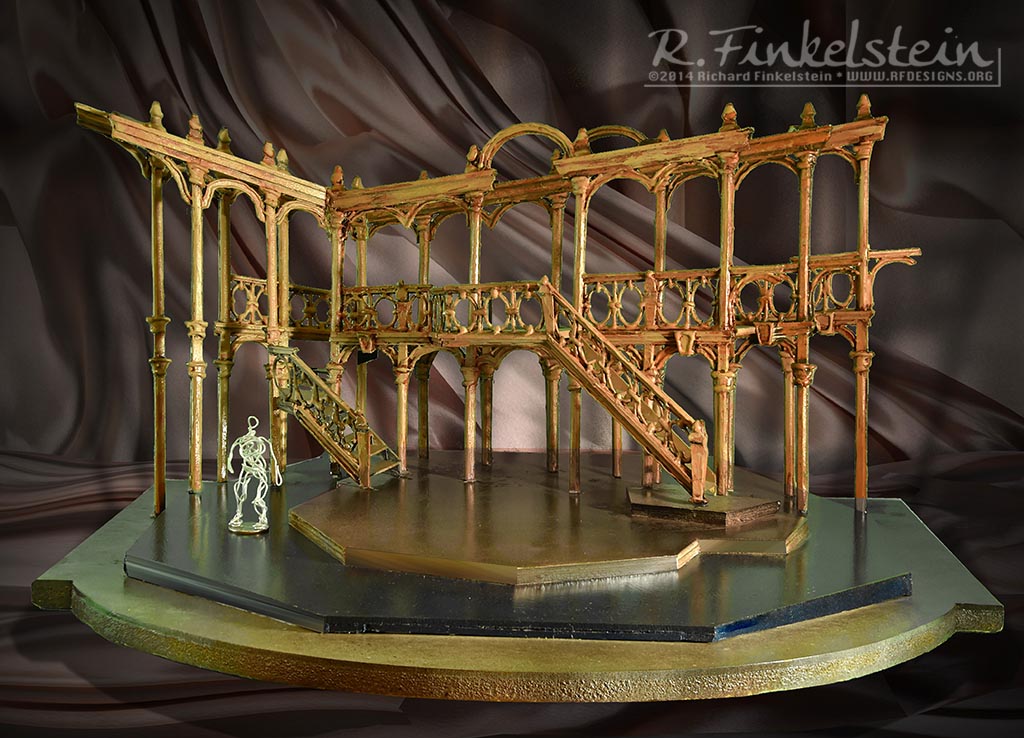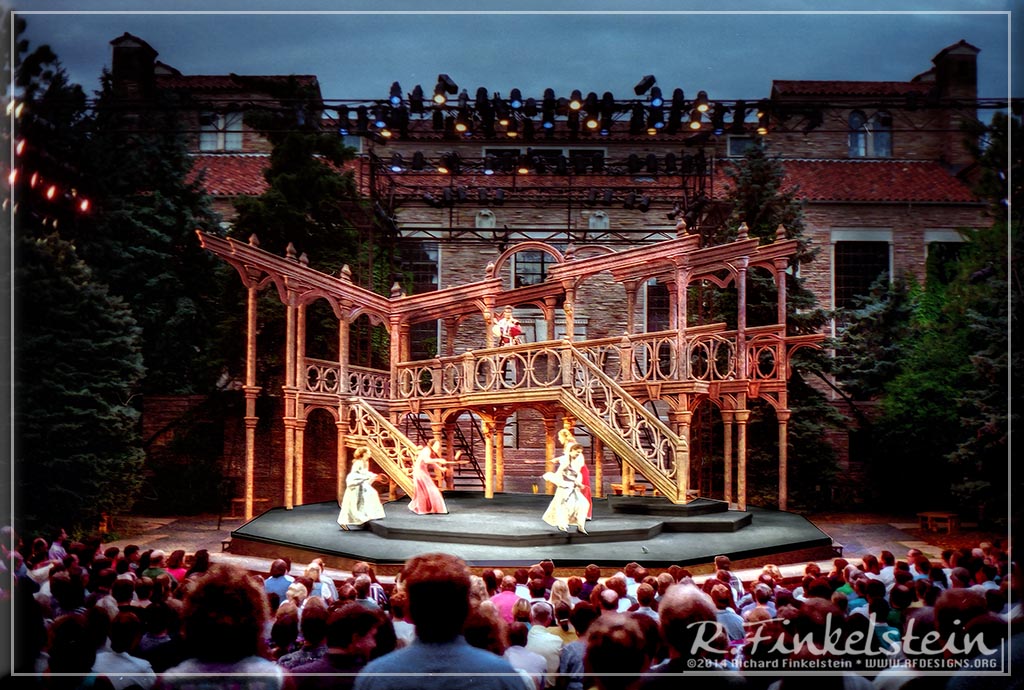Production Photo at Dusk. Through most
of the show the building in the rear
disappears into the night. This shot as is, really shows the total
environment and relationship between the stage and the audience.
One of the many questions Shakespeare poses
in this work is one of whether past circumstances and past
institutional wrongs might alter circumstances of our behavior today.
I have also been intrigued for a long time with the idea that out of
social prejudice, often comes seeds of role reversals, followed by
renewed and further prejudice.
In the case of the latter, there are many
evidences of this process through history. For instance, even today in
American cities with the tallest skyscrapers like New York, the
steelwork is done by members of the Navajo Indian tribe. I surmise
that today they are even paid a great living for this service but the
question is why the profession is dominated by this particular Indian
Tribe. While the uninformed reason that this is because "Indians
are Natural Climbers", this seems to be a generalization, a
racist stereotype. To me the reasoning for this tradition is simply
because at the time of our industrial revolution, the white workers
were not willing to risk their lives for the low wages provided. It
was much easier to assign such duties to the lowest ethnic group in
American social structure, the Indian.
In a more direct parallel to Shakespeare’s
play, one can see a parallel in the society that gave rise to The
Nazis and the Holocaust. Indeed many (though certainly not all)
institutions of business and finances had Jewish ownership. Forgotten
by the Nazis though was the reason for this. Before the rise of
secular business and financial empires, the road to success lie in
land ownership and in military service. Since these were of the most
respected areas of commerce, these areas of enterprise were closed off
to Jews. An earlier generation thus literally forced Jews into the
commercial/financial realm of enterprise. But with time, circumstances
changed, and what had been considered a lowly category of enterprise
became the most envied, and with the reversal of fortunes, old social
hatreds came to the surface in a most dangerous way.
The process even has its analog in the world
of theatre. Even today the field of stage lighting is represented
heavily by the work of Female designers. At the start of the field,
lighting was even dominated by designers from Maude Allen (who the New
York Times claimed to be the inventor of "the light bridge), to
Jean Rosenthal, to Tharon Musser. In the 1970s one set of Tony Awards
was dedicated to the role of Women in the theatre. Each award was
presented by a female leader in the profession, and for lighting the
award was presented by Tharon Musser. She used her time on stage to
address the question of why women were so dominant in the field of
lighting design. By her most plausible explanation, this was because
lighting was not, until recently, recognized as an "art" or
a field requiring particular expertise. Rather, lighting was valued at
first, only in its utilitarian functions. Producers did not want to
invest any of their funds into a "mere utilitarian" function
so they hired women, especially ones that were willing to work for
free, or near free. By the time lighting was recognized as a true art
of the theatre, the women of lighting had the most experience working
in the field.
In the case of Venice of this era, trade was
everything, and trade cannot happen without capital. But loaning money
or charging interest was considered taboo as biblical
"usury". The solution was to "Let the Jews do it".
Many jews became quite wealthy in this process, but the citizens of
Venice still rejected the Jews as a people, as heathens to be scorned.
This was very ironical – out of prejudice, a people considered to be
lower, were given opportunities to become wealthier. Obviously this
was an engine of hate in the making.
In designing this show and its sister, I did
extensive research into both the social and visual history of this
period in Venice. I discovered that the word Ghetto, associated
with Jewish life since the middle ages, was not a generic term at all.
THE Ghetto was one of the islands in Venice. It’s unique geography
afforded it but one way on to the island and off. It became a perfect
location for the Jewish money lenders of Venice to work in the city by
day, while being locked up at night so as not to pose a threat (as
they felt it) to "society" of the day.
In designing this work, I saw the metaphor of
"island prison" as important. The Ghetto of Venice was not
an ordinary prison, Jews were free to travel freely during the
daylight. This Ghetto thus embodied aspects of freedom &
subjugation intertwined.
For this reason, the idea of making this
"prison" lace-like was important to me. This was a prison in
which it’s population was in tantalizing juxtaposition with freedom,
light, and truth. Within this construct, the element of light became
important. Not only can light react to the myriad of architectural
forms; it can also pass through the spaces creating a very directional
composition. The collaborating lighting designer also worked quite
hard to always hint at the water which at once was beautiful, as well
as the prime imprisoning element.
In designing the scenery for this show, I
worked hard to relate the architecture and color of the set to the
buildings surrounding the amphitheater. The natural background to the
Mary Rippon stage is the structure of rear of a natural history
museum. A designer is faced with three choices. The structure can be
ignored, mitigated (although it is too hard to hide), or integrated
into the design. This is most important at the start of each show
while daylight still competes with stage lighting. With my design I
opted for the integrated approach, but I extended the strategy to
mimic the stone of the entirety of the surrounding buildings. This
served two functions. It made the setting look quite a bit larger than
it actually was by extending the style beyond the set borders proper.
The strategy also made the hint that the audience itself was to be put
in the shoes of Venice society of the day.


